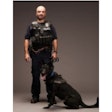Around midnight. Aug. 13, 2003. Officer Kyle Olinger of the Montgomery County (Md.) Police Department patrolled the central business district of Silver Spring.
At the intersection of Second Avenue and Spring Street, Olinger noticed a 1993 Chrysler New Yorker parked in a peculiar manner. With his suspicion aroused, Olinger conducted a traffic stop to investigate further.
A brief exchange with the man in the driver’s seat revealed that he had no license. But since he was not actually operating the vehicle, Olinger simply ordered him out of the car and asked him to move on.
Still, like any good cop, Olinger took note of the incident, and it stayed in the back of his mind as the evening wore on. He was skeptical about why a man with no operator’s license was sitting in a large sedan parked in the center of town. He was obviously waiting for something or somebody.
That healthy skepticism—what’s often regarded as a police officer’s sixth sense—proved right on the mark. Sure enough, Olinger spotted the same car again. Only this time it was occupied by a different driver and three occupants.
At a distance, Olinger watched the Chrysler make an abrupt U-turn and strike a parked car. He immediately activated his overhead lights, pulled over the vehicle, and radioed for backup.
Olinger approached the car in a cautious manner, trying his best to remain out of the “fatal funnel.” He then engaged in conversation with the three passengers and ordered the driver out of the vehicle.
The traffic stop seemed to be going routinely, yet something was wrong. Olinger knew it. He sensed it. And that’s when, out of the corner of his eye, he caught the passenger in the front seat moving about, reaching under his seat.
Olinger recognized the threat. He rushed over to the passenger side of the sedan and, there on the floorboard he saw a pearl-handled, chrome .32 caliber pistol.
That’s when all hell broke loose. As he had trained for so many times before, Olinger established a tactically safe position and drew his Beretta.
Then he took command of the situation. He ordered everybody in the Chrysler to put their hands up. Moving closer, Olinger extended his arm to emphasize his verbal commands.
Everyone complied with Olinger’s orders, except for the front passenger. In one fluid movement, he bent to the floor and retrieved the gun. He was fast. He was also cunning. He grabbed Olinger’s extended arm, gaining a tactical advantage and pulling the officer out of position.
The two men struggled. Then there was a muzzle flash. And a shot rang out.
On the Pavement
Olinger was struck in the throat just above the protection of his ballistic vest. And for one fleeting moment, the world around him went blank. All Olinger can remember seeing is a black hole surrounded by a hazy ring of light.
Time slowed to a crawl. Then Olinger’s head crashed against the pavement. He lay there dazed and confused, unable to defend himself, as he heard the men get out of the Chrysler.
They stood over him, perhaps intending to finish him off. At the very least, they wanted Olinger’s Beretta. Fortunately, Olinger had fallen onto his weapon side, and they couldn’t take his service weapon.
Passing traffic must have spooked Olinger’s attackers because they gave up on trying to take the Beretta. And because he could not move his lower body and his eyes were closed, they wrote him off as dead. They piled back into the Chrysler and raced off from the scene.
After they left, Olinger was able to open his eyes. He knew he’d been shot, and he needed help.
That help came in the form of a cab driver. He had been passing by right after the attack and risked his own safety to come to the aid of the wounded officer. Olinger summoned enough energy to key his lapel microphone while the cabbie broadcast an “officer down in need of assistance” call and recited the suspect vehicle’s tags as a flash lookout to the awaiting units.
The Arrest
The “officer down call” summoned scores of Montgomery County PD officers to Olinger’s aid. First to arrive on the scene was the department’s Bethesda SWAT team. Although he was vacillating between states of awareness and unconsciousness, Olinger managed to provide them with a detailed description of his assailants and how he’d been shot.
Armed with that information, the Montgomery County officers fanned out in an extensive manhunt, meticulously canvassing the landscape for the would-be cop killers.
Perhaps there is no stronger motivation in law enforcement than to bring someone who harms your own to justice. The Olinger manhunt benefited from that emotion. Within a short span, all the suspects, including the shooter, were taken into custody and the Chrysler was recovered.
The Trauma Center
While the suspects were being apprehended, Olinger was whisked away to the Washington Hospital Center, a specialized trauma facility. Montgomery County officers, as well as the entire Washington area law enforcement community, flocked to the hospital and set up a continuous vigil. They didn’t know whether Olinger was going to live or die.
After nine hours of surgery, doctors told the officers that Olinger was going to live. But they had bad news as well. The risky operation had saved Olinger’s life, but the surgeon could not extract the .32 slug that jammed against his cervical spine. Olinger was paralyzed from the chest down. He was told he’d never walk again.
The Adjustment
As the weeks turned to months, recovery was replaced by rehabilitation. Olinger was flown to the Craig Hospital in Englewood, Colo., one of the top brain and spinal cord injury therapy centers in the country. The Montgomery County PD paid the entire cost of the three-month treatment program as part of its ongoing commitment to stand by Olinger.
Over the next year, adjustment proved to be a slow, arduous process. Now confined to a wheelchair and without the use of his legs, Olinger painstakingly relearned just about every aspect of normal life. Simple tasks that he had once accomplished in a couple of minutes now took up to half an hour to complete.
Such an adjustment is tough enough for a person living alone. But Olinger is a single father. The combination would have proved overwhelming for many people, but not for Olinger. He confronted all of his challenges head on.
Justice Served
Six months after the shooting, the triggerman faced his day in court. The Rockville courtroom was packed with an array of media, Olinger’s family, and his fellow officers from the Montgomery County PD.
After disposing of preliminary challenges and laying down the basic legal groundwork, the prosecution swiftly proceeded to the focal point of its case: Olinger’s testimony.
The gallery quieted as Olinger and the Maryland State’s Attorney, who played the role of the shooter, re-created the events of that night. Their reenactment was aided by the presence of the actual passenger side of the vehicle. It was removed from the car and reassembled in the courtroom to provide the jurors with a vivid visual reminder of the attack.
Presented with this compelling testimony and convincing physical evidence, the jury deliberated less than two hours before coming back with an attempted first-degree murder conviction and two lesser charges.
Throughout the entire proceeding, Olinger’s assailant remained cold and aloof and expressed absolutely no remorse for his crime. But he will have time to think about his crime. The judge handed down a prison term of life, the maximum penalty allowed by Maryland law.
A New Life
Some people would say that Olinger’s attacker got what he deserved. He’s locked away for life. But looking at the brawny former Marine and dedicated cop who is now locked for life into a wheelchair, it’s hard to see the justice.
Understandably, the verdict provides little solace for Olinger. Gone forever is his ability to remain physically active. And simple activities that once brought joy to his life were taken away by the shooter’s decision to attack. Worst of all, he can no longer wrestle and roughhouse with his teenage son or go for long runs to stay in shape. “ There are things worse than death in this life,” Olinger says. “For me, it’s paralysis”.
Today, the experts give Olinger a one in 99 chance that he’ll ever walk again. Not great odds, if you’re betting in Vegas. But there is that one percent. And for Olinger, that’s enough to keep him striving toward that goal.
Olinger participates in an intense aqua therapy regimen and he submits to acupuncture. He also believes that perhaps some forthcoming medical advance will someday help him regain his mobility.
A lot of people would have long ago given up, but Olinger keeps pushing. He credits his positive mind-set to his martial arts training. Olinger is a third-degree black belt with 26 years of experience, and he continues to verbally instruct from a wheelchair at his Aikido studio in Mount Airy, Md.
Olinger has also returned to work with the Montgomery County PD as a detective with the Special Investigative Division. His new role involves interpreting intelligence and preparing briefs for the department.
His new position is a desk job. But Olinger still thinks like a street cop. He’s still a sworn officer, and he still qualifies and carries his issued firearm. As Olinger would tell you, once a cop, always a cop. And his paralysis doesn’t stop him from serving his community and his fellow officers.
Lessons Learned
Olinger says there are many things he could have done differently the night he was shot.
When the front seat passenger reached for the weapon on the Chrysler’s floorboard, that justified the use of deadly force. Olinger now believes he should have fired and neutralized the imminent threat to his safety.
He remembers that he rapidly took into account the assailant’s age and center mass of his target area. But he didn’t have a shot. All he could have done was shoot the man in the back of the head and that would have given the shooting the appearance of a police-sanctioned, execution-style killing. Olinger says the prevalent anti-law enforcement sentiment of jurors throughout the country flashed through his mind as he thought about taking the shot, and he held back in restraint. Unfortunately, it almost cost him his life.
Olinger now serves as a living warning for other officers, and he wants them to learn from his experience. Already, the Olinger shooting is being studied at the Montgomery County Police Academy.
Someday the man who experienced this tragedy first-hand would like to teach this case study himself. Olinger aspires to return to the academy to tell his story to a new generation of recruits. “If I can no longer help people with my physical presence as a street officer, I can help them with my mind,” he says.
With the department, the local Fraternal Order of Police, and the community passionately supporting his uphill struggle, it appears that the most difficult part of Olinger’s ordeal is behind him. Although his life will never be the same as before the shooting, a bright new horizon of possibility has risen from the darkest depths of Kyle Olinger’s worst nightmare.
David J. Terestre is a nationally published writer on topics involving police work and the criminal justice system. A frequent contributor to Police, he is an officer with the Fourth District of the Metropolitan Police Department, Washington, D.C.
Beyond the Darkness
Around midnight. Aug. 13, 2003. Officer Kyle Olinger of the Montgomery County (Md.) Police Department patrolled the central business district of Silver Spring.












